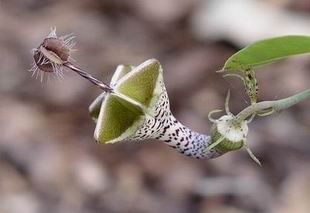(单词翻译:单击)
听力文本
This is Scientific American — 60-Second Science. I'm Christopher Intagliata.
Honeybee stings are painful. But they're also... fragrant. "If a beekeeper gets stung by bees, it smells like banana." Dr. Stefan Dötterl, a plant ecologist at the University of Salzburg in Austria.
That banana scent, he says, is a compound called isoamyl acetate — also known as banana oil. It's one of many compounds produced when a bee stings — a mix of alarm pheromones that let the hive know that another bee's in danger.
But that chemical cocktail doesn't just attract other bees. It also draws tiny flies known as kleptoparasites, "or so-called 'food stealers'." The flies feed on the drippings of bees being devoured by spiders. And they sense the bees' chemical calls for help as a dinner bell.

Turns out, though, it's not the flies... but a flower that has the last word in this tale of trickery. Because researchers have now discovered that the flowers of a South African plant — called the parachute plant — produce nearly three dozen of the 90-some compounds in that honeybee alarm call. Meaning they mimic the scent of a honeybee in danger — to lure in and temporarily trap the flies, as a pollination ploy. The findings are in the journal Current Biology.
The plant of course isn't aware of this bait-and-switch. "It's just by chance that this plant produced these compounds and attracted these small flies as pollinators. And thus by time, it was possible to refine these plants, and to add another and another compound to finally get such a nice cocktail." A cocktail, though, that won't be followed by a meal.
Thanks for listening for Scientific American — 60-Second Science Science. I'm Christopher Intagliata.
参考译文
这里是科学美国人——60秒科学。我是克里斯托弗·因塔利亚塔。
被蜜蜂叮一下非常疼。但同时,伤口处也会留有香味。“如果养蜂人被蜜蜂蛰到,伤口处的味道闻起来像香蕉。”斯特凡·多特尔是奥地利萨尔茨堡大学的植物生态学家。
他表示,这种香蕉的香味其实是一种名为乙酸异戊酯的化合物,也被称为香蕉油。当蜜蜂叮咬时,其实会产生很多化合物,多种警报信息让蜂群知道,有蜜蜂身处危险。
但是这种化学混合物并不会吸引其他蜜蜂。相反,它会吸引一种小型苍蝇,这种苍蝇被称为“偷寄生蜂”或者也被称为“食物小偷”。这些苍蝇以蜘蛛吞食的蜜蜂肉汁为食。它们将蜜蜂的化学求救信号视为“晚饭铃”。
研究结果表明,这场骗局最后的胜利者其实是一种花,而不是苍蝇。因为研究人员发现,南非一种植物开的花被称做降落伞花,这种花可以产生蜜蜂警报信息中约90种混合物的其中36种。这也就意味着,这些花模仿了蜜蜂发出的危险信号,来引诱和暂时诱捕这种小苍蝇,这是它们授粉的方法。这项研究结果发表在《当代生物学》杂志上。
当然,这种植物并没有意识到这是一种诱骗。“这种植物产生这些化合物来吸引这些小苍蝇来授粉。当然,时间或许可以使这些植物进化,进而产生其他的化合物,最终产出一种绝美的混合物,就像鸡尾酒一样。”不过鸡尾酒之后并没有一顿美味的大餐。
谢谢大家收听科学美国人——60秒科学。我是克里斯托弗·因塔利亚塔。
译文为可可英语翻译,未经授权请勿转载!
重点讲解
重点讲解:
1. be known as 称为;叫做;
例句:This is known as floating-point representation.
这就是所谓的浮点表示法。
2. turn out 原来是;结果发现;
例句:If it does turn out that you have done something wrong, be quick to say "sorry" .
如果结果证明你确实做错了什么,要赶紧说“对不起”。
3. have the last word (讨论、争论、分歧中的)最终决定权;
例句:She does like to have the last word in any discussion.
她确实喜欢商量什么事都最终自己说了算。
4. be aware of 注意到的;察觉到的;意识到的;
例句:John has been aware of having done something wrong.
约翰已意识到自己做错了事情。


